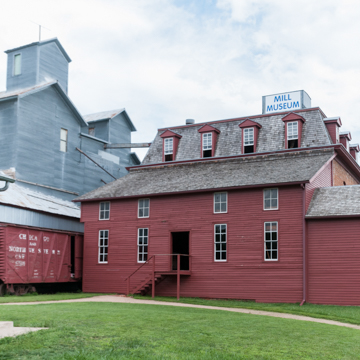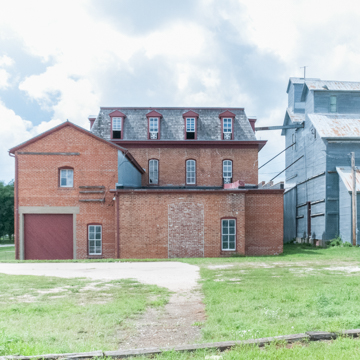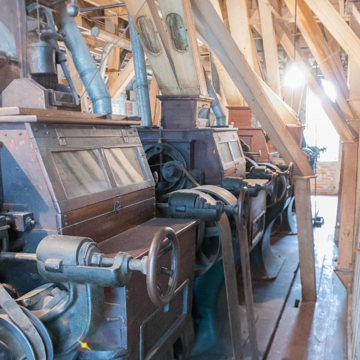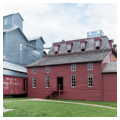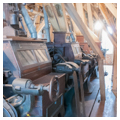The Neligh Mill is one of the oldest and best-preserved flour mills in Nebraska. The establishment of flour mills aided rural settlement and town growth in the plains during the late nineteenth century and played an important role in the state’s agricultural and economic development. In 1873 John D. Neligh, founder and namesake of the newly platted town, began construction of the mill adjacent to the Elkhorn River. The financial panic of 1873 forced Neligh to sell the unfinished building to William Gallaway, who completed construction and began milling operations the following year. The original portion of the complex is a two-story, pressed brick structure capped with a mansard roof. Power was generated by means of a dam, constructed to channel water to a large wooden turbine that operated millstones, later replaced with rollers.
The need for more grain storage space resulted in the construction of support buildings immediately north of a railroad siding that bordered the original mill. These included a one-story flour warehouse and multistory wheat elevator, both built in 1886. A corn elevator was constructed in 1899 between the warehouse and wheat elevator, connecting the buildings. All three buildings are frame structures with gable roofs and clad with corrugated metal siding. These buildings greatly increased the capacity of the mill, ultimately making it the largest milling company in northeastern Nebraska. Consequently, this expansion created the need for a source of power greater and more dependable than water. In 1900–1901 a brick annex housing an electric power plant was attached to the east side of the original building. Although the waterpower system had been substantially improved during the early 1900s, a disastrous flood in 1920 effectively eliminated water as a reliable source of power.
During the early decades of the twentieth century the mill was operated by a succession of owners and continued to grow in importance. It produced livestock feed as well as a variety of flours and other products, many of which were shipped to Europe and throughout the United States. Business began to decline in the 1940s and flour milling ceased in 1959. Ten years later the state legislature provided funds for the purchase of the mill by the Nebraska State Historical Society. Today, the Society operates the mill as a branch museum. One of its principal exhibits is the original nineteenth-century milling machinery, said to be in operating condition. Reconstruction of the flume and penstock in 1975 has preserved the important role that water played in the early success of the milling operation.
References
Magie, John Q., “Neligh Mill," Antelope County, Nebraska. National Register of Historic Places Inventory–Nomination Form, 1969. National Park Service, U.S. Department of the Interior, Washington, DC.














